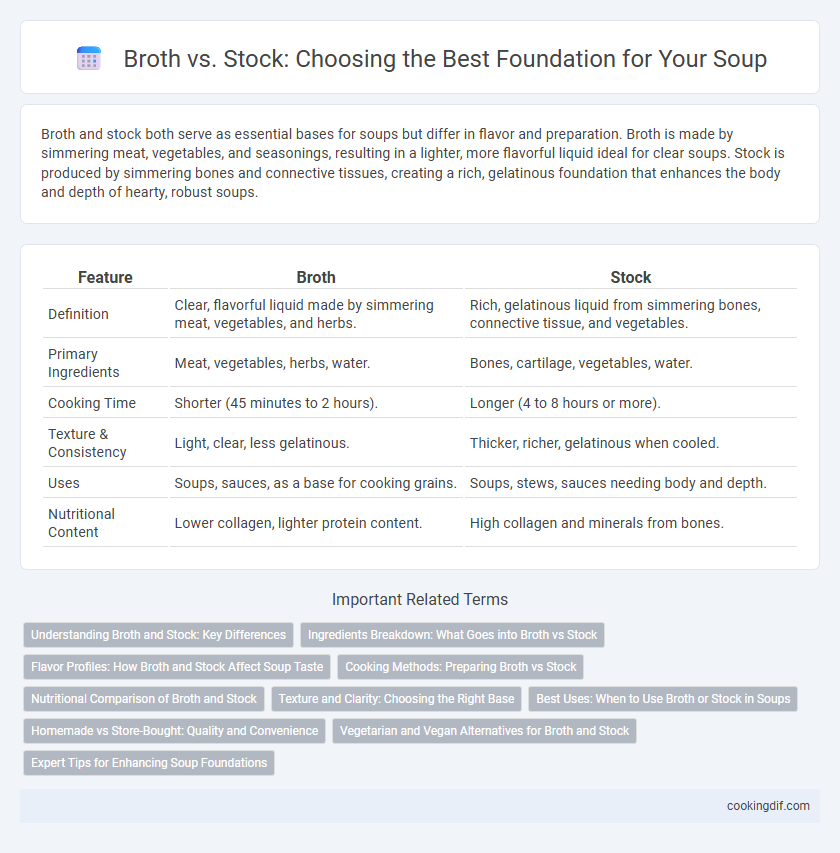Broth and stock both serve as essential bases for soups but differ in flavor and preparation. Broth is made by simmering meat, vegetables, and seasonings, resulting in a lighter, more flavorful liquid ideal for clear soups. Stock is produced by simmering bones and connective tissues, creating a rich, gelatinous foundation that enhances the body and depth of hearty, robust soups.
Table of Comparison
| Feature | Broth | Stock |
|---|---|---|
| Definition | Clear, flavorful liquid made by simmering meat, vegetables, and herbs. | Rich, gelatinous liquid from simmering bones, connective tissue, and vegetables. |
| Primary Ingredients | Meat, vegetables, herbs, water. | Bones, cartilage, vegetables, water. |
| Cooking Time | Shorter (45 minutes to 2 hours). | Longer (4 to 8 hours or more). |
| Texture & Consistency | Light, clear, less gelatinous. | Thicker, richer, gelatinous when cooled. |
| Uses | Soups, sauces, as a base for cooking grains. | Soups, stews, sauces needing body and depth. |
| Nutritional Content | Lower collagen, lighter protein content. | High collagen and minerals from bones. |
Understanding Broth and Stock: Key Differences
Broth and stock serve as essential foundations for soups, with broth typically made by simmering meat, vegetables, and herbs, resulting in a flavorful, seasoned liquid suitable for direct consumption. Stock is primarily created by simmering bones with minimal seasoning, producing a richer, gelatinous base ideal for enhancing texture and depth in soups. Understanding the differences in ingredients, cooking time, and flavor concentration is crucial for selecting the appropriate foundation in soup preparation.
Ingredients Breakdown: What Goes into Broth vs Stock
Broth is typically made from simmering meat, vegetables, and seasonings, resulting in a lighter and more flavorful liquid that can be consumed on its own. Stock involves simmering bones, often with some meat still attached, along with vegetables and aromatics, producing a richer and gelatinous base due to collagen release. The key difference lies in broth's emphasis on meat and flavor, while stock relies on bones for depth and texture in soups.
Flavor Profiles: How Broth and Stock Affect Soup Taste
Broth offers a lighter, clearer flavor with subtle saltiness, making it ideal for delicate soups and enhancing the natural taste of ingredients. Stock provides a richer, more robust flavor due to its longer cooking time with bones and connective tissues, adding depth and body to hearty soups. Choosing between broth and stock significantly influences the soup's overall taste, texture, and complexity.
Cooking Methods: Preparing Broth vs Stock
Broth is made by simmering meat, vegetables, and aromatics for a shorter time, typically 45 minutes to 2 hours, which results in a lighter, more flavorful liquid. Stock requires a longer cooking process, often 4 to 6 hours or more, with bones, connective tissue, and aromatics, producing a richer, gelatinous base due to the collagen breakdown. Both methods use simmering rather than boiling to extract flavors and maintain clarity in the liquid.
Nutritional Comparison of Broth and Stock
Broth typically contains more protein and is lower in fat compared to stock because it is made primarily from meat and simmered for a shorter time, preserving more nutrients. Stock, simmered longer with bones and connective tissues, provides higher collagen content, which may support joint health and digestion but generally has fewer proteins. Both offer unique nutritional benefits, with broth favored for protein intake and stock valued for its gelatin and mineral content.
Texture and Clarity: Choosing the Right Base
Broth offers a lighter, clearer texture ideal for delicate soups and consommes, emphasizing a clean, transparent appearance. Stock, simmered longer with bones and connective tissues, provides a richer, gelatinous texture that enhances mouthfeel and adds depth to hearty soups. Prioritizing clarity makes broth preferable, while texture and body favor stock as the foundational soup base.
Best Uses: When to Use Broth or Stock in Soups
Broth, made by simmering meat and vegetables, offers a lighter flavor ideal for clear soups and quick-cooking dishes, while stock, rich with collagen extracted from simmered bones, provides a fuller body perfect for hearty stews and sauces. Use broth when a delicate, subtly flavored liquid base is desired to complement fresh ingredients without overpowering them. Choose stock when a robust, gelatinous foundation is needed to add depth and richness to slow-simmered soups and complex recipes.
Homemade vs Store-Bought: Quality and Convenience
Homemade broth offers superior flavor complexity and nutrient density compared to store-bought options, thanks to fresh ingredients and slow simmering that extract gelatin and minerals from bones and vegetables. Store-bought broth provides convenience with long shelf life and quick preparation but often contains additives, high sodium levels, and less depth in taste. Choosing homemade stock enhances soup foundations with richer mouthfeel and customization, while store-bought stock suits busy cooks seeking time-saving solutions without sacrificing basic quality.
Vegetarian and Vegan Alternatives for Broth and Stock
Vegetarian and vegan alternatives for broth and stock use vegetable scraps, herbs, and spices to create rich, flavorful bases without animal products. Vegetable broth typically simmers vegetables like carrots, celery, and onions for a lighter taste, while vegan stock often incorporates mushrooms, seaweed, and nutritional yeast for deeper umami and complexity. These plant-based liquids serve as essential foundations for soups, enhancing nutrition and maintaining authenticity in vegan and vegetarian cooking.
Expert Tips for Enhancing Soup Foundations
Broth, typically seasoned and simmered with meat, vegetables, and herbs, offers a lighter, clearer base ideal for delicate soups, while stock, made from simmering bones with minimal seasoning, provides a richer, gelatinous foundation perfect for hearty or creamy soups. Experts recommend roasting bones and vegetables before simmering stock to deepen flavor and improve color, while clarifying broth by skimming impurities ensures a clean taste and appearance. Incorporating a mirepoix blend and controlling cooking time--shorter for broth, longer for stock--optimizes the balance between flavor intensity and texture in soup foundations.
Broth vs Stock for soup foundation Infographic

 cookingdif.com
cookingdif.com